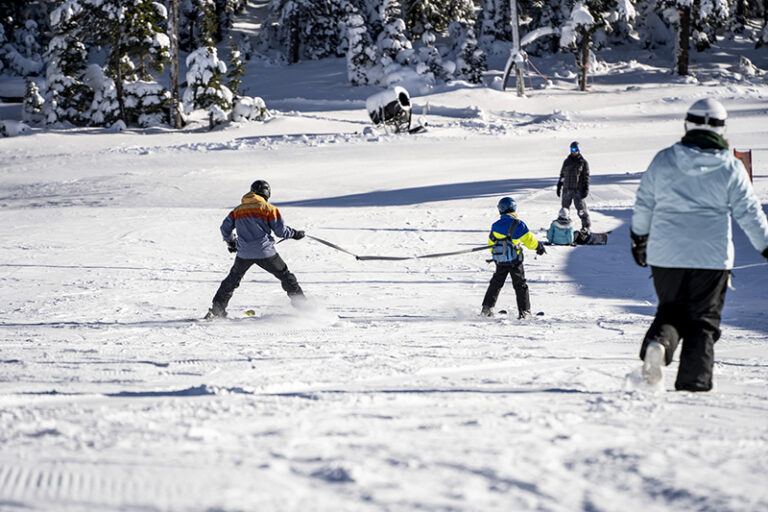It’s the onset of June, and the 80 and 90 degree temperatures in Spokane. That sloper at Deep Creek actually seems greasier. By this time, visiting the same cliffs with the same folks all spring can leave one lethargic and hot, diminishing the motivation to climb. The remedy is simple. Its a summer road trip to a good summer crag. Ten Sleep, Wyoming is one such climbing area that deserves a visit.
Ten Sleep, population 304, is merely the town that lies 10 miles west of the canyon where the cure exists. Look at a map of Wyoming, find dead center, then look a bit north into the Bighorn Mountain range and there’s the town. It’s about a three-hour drive south of Billings Montana, or a ten-hour drive from Spokane. By horseback its exactly, ten sleeps between Bridger, Montana and Casper, Wyoming, which was an old trade route.
Peer down the main drag and there are two cafes, two saloons, a souvenir shop, a gas station, and a church. One Cafe has the classic greasy spoon breakfast. The espresso cafe, has wi-fi and your typical espresso bar type fare. The Ten Sleep Saloon serves cheap, tasty steaks and cold beer. There isn’t a grocery store or a climbing shop but there are two grocery stores 30 miles to the west in Worland. Bring extra climbing gear since the nearest gear store is three hours away in Lander, Wyoming.
The approximately 10-mile long canyon runs northeast to southwest and ascends the western slope of the Bighorns. Upon entering the canyon on Highway 16, the canyon walls are constricted, and start as red sandstone, then white sandstone, then limestone, finally changing to Big Horn Dolomite and widening out to about two miles across. Highway 16 runs on the northern side of the canyon and old Highway 16 (a dirt road) runs on the southern side of the canyon. Ten Sleep Creek runs through the center of the canyon where grazing cattle dot the sage brush meadows that parallel the creek.
The “Bighorn Dolomite, Ordovician” sign is at around 6000 feet but higher up the canyon there are many cliffs at 8000 feet. Although the altitude may take some getting used to, the 15 to 20 degree cooler temps will be welcome. The altitude also makes for a short season from June till mid September. In addition to the altitude, the cliffs are shaded on the southern side of the canyon in the morning and the northern side of the canyon in the afternoon.
Once in the climbing zone, the guidebook, Ten Sleep (Heavenly Thunderstorm Opens Up New Universe), by Aaron Huey, is indispensable in its description of 545 sport climbs from 5.6 to 5.14c. It makes sense out of the miles of cliff line and will save hours of aggravation navigating this immense area. Approaches are well marked and can vary from a minute to 45 minutes. The longer approaches ascend gently sloping terrain in sage and wild flower meadows, before turning up through fir trees that shroud the faces of the cliffs. Shorter approaches start and end the same but don’t last as long.
Spokane climbers familiar with Dishman, Post Falls, and Rocks Of Sharon will be comfortable with the vertical, small hold climbing theme, but the currency of climbing Ten Sleep is pockets. Walls are slabby to gently overhanging. Bring stiff edging shoes with a chisel toe for little water dishes and holes. Be prepared to stand on very small features.
A unique aspect about climbing here is the high quantity of quality moderate sport climbs from 5.8 to 5.11. Routes here are ideal for the moderate climber looking to get a lot of mileage in. One casual, cliff classic, Beer Bong, 10b, is a must do. It has the standard, pocketed, face climbing start, but works into a giant, tubular, feature that has had the back quarter of the tube removed. Like a chimney, but protruding off the main face by ten feet, climb it facing into the canyon or facing into the cliff. A novel route either way. The 5.12 grades on up get more technical with an endurance factor thrown in the mix. Classics such as Esplanada, 12d, throw some steeper, two-finger pocket climbing in the lower 50 feet, just to pump the forearms for the extremely thin run out slab to the anchors. It’s not uncommon to see good climbers Elvis leg, then fall at the chains through the fir tree branches behind the route.
When the climbing day is over, camping in the canyon is plentiful, peaceful, and free but limited to 15 days at a time. The good sites are on old Highway 16 at the top of the canyon. Mosquitos can be thick so bring bug spray. If it’s near the Fourth of July, it will be busy and disregard the last couple sentences. On the third and fourth of July, Ten Sleep shuts main street down, has live music and dancing at night, then a parade and a rodeo in the day, followed by more music and dancing in the night.
On a rest day, check out the Dinosaur Museum and hot springs in Thermopolis. There are three hot springs right next to one another. The state-run hot spring is free. The locals claim that the Dinosaur Museum keeps the good finds and sells the lesser finds to places like the Smithsonian. Buffalo, Wyoming, just over the pass from Ten Sleep, has a pool the size of a city block that’s free. The drive over the pass is beautiful in itself. It reaches an elevation of 9660 feet, while circling around Cloud Peak at 13,167 feet. Wyoming only has a half million residents so finding urban type outings is out of the question. If cool weather climbing and getting away for a bit is the prescription, Ten Sleep is the cure. Cowboy up.













